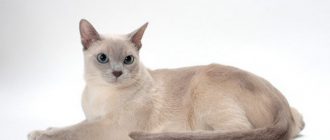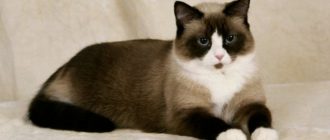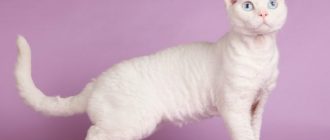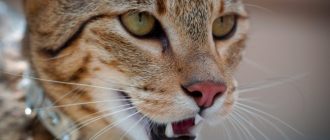Brief description of the breed
Contents
Siberian cats are the real pride of our country. Even them himself appearance majestic, wise. These are cats, officially recognized in the USSR only in 1989, but in reality they lived on the territory of the Far East and Siberia as early as the 16th-17th centuries. one decade, cats of this breed are loved in Europe, but all their homeland is Russia, therefore it is in our country of these animals revered more than anywhere else. Distinctive features Siberians – a half-long thick coat, a powerful muscular body, strong character, big and very smart eyes. In size they belong to the medium and large category of cats, the weight of males is within 6-12 kg, females – 4-8 kg. Siberian cats – animals with strong bones, massive, cats always look larger than cats. The head of the Siberians is quite large, proportional to the body, forehead low, chin strong and wide. The nose is straight, medium length. The eyes are large, wide apart, oval, look attentive and direct (eye shades – green, yellow, blue (with coat colors white and color point), heterochromia (different shades eye) is found in white cats). The ears are wide apart, medium in size, wide at the base, rounded at the tips, most often with brushes. The neck is short or medium length, powerful. The chest is wide. The body is muscular, long, limbs medium length, very strong and muscular. Paws are large, rounded, a thick coat grows between the fingers. The tail is rather long, fluffy. The coat is medium-long, very dense, soft on the sides, whereas integumentary water-repellent hair tougher, always present a mane, a collar and pants made of embellishing thick wool. Undercoat well developed, shorter than coat. Especially in winter Siberian cats look luxurious – then their coat is the thickest, shiny and fluffy. The colors of cats of this breed – black, blue, white, apricot, color point, smoky, bicolor, tortie, tabby.
Photo of a Siberian cat:
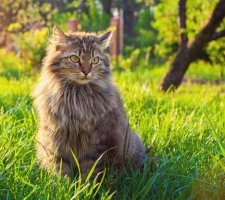
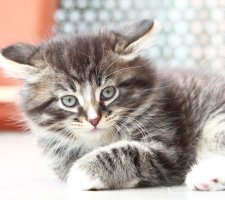
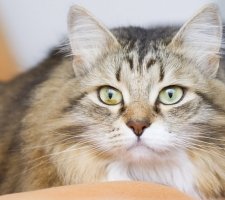
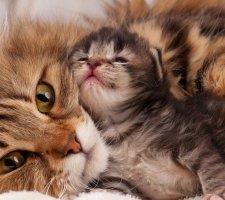
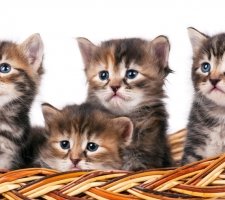
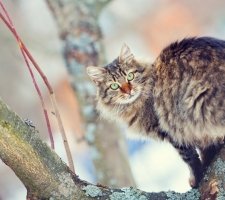
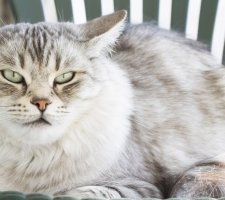
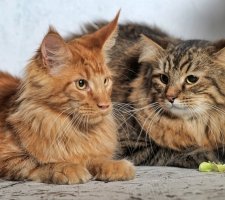
 Pictures of Dog Breeds |
Pictures of Dog Breeds |
The history of the Siberian cat
The history of the Siberian cat is full of legends and various myths. She almost a thousand years old. The birthplace of this breed is considered to be Siberian taiga located on the territory of modern Russia. Like the Norwegian forest cat, as well as Maine Coon, Siberian cat belongs to the group of forest cats. Siberian cat is the only native breed of cats in Russia. As in most cases indigenous research, exact location and features the origin of this breed has not yet been established. Some researchers believe that she appeared as a result of mating wild cats of Trans-Urals with cats brought from Europe. It is known for certain that the ancestors of the modern Siberian cat are wild forest as well as steppe cats that were beautiful but ruthless hunters. It is these qualities, and also a sufficiently large size of animals caused that Siberian cats became the heroes of many Russian folk tales. IN of them they most often acted as defenders. Although Siberian cats and considered indigenous, it could not have done without a long painstaking the work of Soviet breeders. For the sample to create Siberians Bukhara breed of cats that had sunk into oblivion was taken territory of Siberia. These animals were very muscular thick long hair and stamina, they were also called Siberian for good health, excellent appearance and their place residence. That is why the first mention of Siberian cats appeared several centuries ago, although official recognition felinologists happened only in 1989. In other words, modern Siberian cats – the same Bukhara cats, somewhat “honed” genetic scientists in the second half of the 1980s. The appearance of the same Bukhara cats in the Siberian taiga is covered in secrets. One by one versions, these cats got there from Central Asia (more precisely, from the ancient city of Bukhara). Another variant of the appearance of Bukhara cats in Siberia – they were imported by a team of Cossacks Ermak during his campaign on the Siberian Khanate. There is even a version as if Bukhara cats – the ancestors of manuls (wild cats of small size with very thick coat). But scientific evidence about the appearance of these animals, unfortunately, no. Yes, and was not carried out in the New time is still breeding activity, therefore called Bukhara could be any long-haired cats, whose thick hair was caused by severe climatic taiga conditions. The archives preserved information confirming that Siberian cats were the constant companions of many monks, more Moreover, in some monasteries they were used as watchdogs. animals. This breed was also popular among traders. They held back Siberians to fight rodents. Sometimes shopkeepers even organized unofficial exhibitions at which they competed in the size of your pets. The first official participation of the Siberian The cat in the exhibition was recorded in England in the 18th century. nineties the breed standard was formally developed. After This breeders began active work on breeding. The popularity of fluffy Siberian cats began to grow rapidly. only in Russia, but also abroad.
Siberian cat character
Siberian cats in their behavior are somewhat reminiscent of dogs. They are such devotees are also strongly attached to their master. Pets always look forward to their owner and joyfully greet his. But they give their attention and love not only to the owner, but to everyone family members. They love to play with kids and never show aggression. Siberian cat is a faithful companion. Pets hard endure separation and loneliness. They get along well with others pets. Often cats of this breed are friends even with dogs, although not always. Siberian cats are often compared to guard dogs. They will tirelessly guard their territory. On any encroachment by a stranger, the animal will react with a fierce hiss. Although the character of a Siberian cat and is friendly, yet they do not like excessive affection. More characteristic for the animal is communication with the owner on an equal footing. TO the cat needs to be treated not as a toy, but as a friend and a full member of the family. Siberian cats are physically developed, such nature itself endowed them with qualities. They are full of vitality. Pets of this breed are difficult to keep in place, they adore Jump, run and climb in search of new adventures. Wherein damage to the decor or interior of an apartment is extremely rare. active training should be selected during training and not dwell on one thing, otherwise such an activity will quickly get bored. Please note that Siberian cats adore everything that way or otherwise, associated with water. For example, they can watch for hours water flow or even dripping from a tap. It can be used during training. The special nature of the animal suggests that in the process of training can cause certain difficulties. You will have to be patient and persevere.
Maintenance and care
The chic appearance of Siberians is a large body size, thick and rather long coat make some potential buyers refuse to buy because of fear of painstaking daily care. But actually the content of the Siberian cat The breed is not overly complex. These are the main tasks that face the owner:
- Combing – it is carried out during molting daily, and in normal time no more than 1-2 times a week. For removal procedure wool will need a slicker, a brush and a rubberized glove. IN in some cases, a spray against tartan can be helpful, which facilitates combing and helps unravel the fallen wool;
- Bathing – it is carried out no more than several times a year, since Siberian wool has the ability to self-clean. Naturally, if the animal is contaminated, then it should be bathed with shampoo for longhair cats using conditioner balm and then dry thoroughly (you can use hair dryer) and comb;
- Clipping – done with a clipper twice in month. During the procedure, it is desirable to fix the animal with using a towel, and then gently cut off the edge of the overgrown claw, without damaging the blood vessels;
- Ear cleaning – it is carried out weekly with cotton sticks moistened with water. You can purchase a spray to remove sulfur from the ears of a cat. Care should also be taken during cleaning. inspect the auricle – is it purulent or dark brown discharge (this may be a symptom of the disease);
- Brushing teeth – not all cats will agree to this, especially if the owner did not accustom the animal to the procedure from an early age. In these Often, cleansing sprays come to the rescue (they are not needed rinse or brush) and goodies (containing meat or fish) fighting plaque. But the best option is cleaning with brushes and toothpaste purchased at a zoo pharmacy;
- Eye Care – Using a Cotton Swab or Clean tissue wipes soaked in boiled water (infusion of chamomile, marigold, tea leaves), the cat rub their eyes from the inside corner to the outside.
A Siberian cat can be kept in an apartment and in a private house. For animal, you need to select the corner in which they will be located a stove bench, a bowl of water, toys, a scratching post and a tray. Preferably so that the place of sleep and rest of the cat is not near the battery and not on a draft. Since Siberians are rather big cats, then their bed must be of appropriate size. Bowls are best purchased at 3 pieces (for water, dry (if you plan to feed animal industrial feed) and liquid food) from glass, ceramics or steel. The cat’s bowls should always be kept clean – after each meal should be washed, and water should be changed 1-2 times day. Scratching post and toys (or maybe a game complex) will allow the cat is warming up when the owner does not have time for games. Wherein the claw point should be high enough to match pet, and toys are best purchased without small parts (feathers, beads, buttons, etc.) that are easy to bite and swallow. Tray for a Siberian pet it is better to choose a roomy one, so that in it the animal was comfortable. Be sure to regularly change the filler and wash the tray as an unpleasant odor can cause the cat to look another place for the toilet.
Feeding
Siberian cats may be prone to obesity, therefore, adult the individual is fed twice a day, pouring the amount of feed into the bowl according to the weight of the animal and its individual characteristics (this is approximately 200-250 g or a little more). The main types of food – natural and ready-made, although combined (combining owner-prepared food with canned food and dry feed). Natural Nutrition Is Fresh Food good quality. The basic composition of the natural menu is approximately such is:
- Meat – it is given every day, after boiling or dousing boiling water, you can also give raw meat, past the process frosts. It’s best to choose lean, boneless meat (veal, chicken, rabbit, lamb, turkey);
- Offal – they are given in boiled and crushed form 1-2 times per week (kidneys, liver, heart, etc.);
- Fish – it should not be abused, so give it no more than 2 once a week, only marine and preferably non-greasy (cod, pollock, tuna);
- Vegetables – some pussies do not like them, so before serving you can weld and grind them in a blender, adding a little vegetable oil (linseed, olive, etc.). They have to be present in a plate every day or every other day. The best thing give cabbage, carrots, zucchini, beets, pumpkin, which before serve can be mixed with meat, offal or fish;
- Greens – it is finely chopped, and then added to the main dish. Most often, parsley and dill are used;
- Cereals – you should not feed the cat porridges daily, but you can alternate with vegetables, adding to meat (offal, fish). The best cereals – rice, oat, buckwheat;
- Eggs – their cats should receive boiled form no more than 1-2 times in Week. You can add crushed egg to the main dish;
- Sour-milk products are low-fat and fresh kefir, curdled milk, cottage cheese. They can be given daily or every other day.
Ready-made feed Ready-made feed can be in the cat’s diet in a dry or wet. At the same time, it is worth giving preference to goods high quality – premium and extra premium. Good industrial feeds can be special and medicinal (if, to for example, a cat suffers from urolithiasis or is sterilized), Designed for kittens, active adults or the elderly. The advantages of ready-made feeds are time saving (no need to cook), balance (contain all the necessary vitamins and minerals), variety (many tastes).
Health and Disease
Siberian cats have an excellent level of health, which allows they reach 20 (sometimes even more) years. We can safely say that these animals have Siberian health – they are hardy, good tolerate heat and frost, do not have genetic diseases. Cats able to bring offspring right up to the venerable age – 17-18 years old. With good nutrition and proper hair care, due attention to the possible dangerous symptoms of various diseases (low or high temperature, disorders Gastrointestinal tract, depression, refusal of water and food, dullness and hair loss, abnormal discharge from the ears, eyes, nose and etc.) for their whole life they may not suffer from any serious ailment. However, they may have some problems in old age. with musculoskeletal system, cardiovascular system, digestion, but even these misfortunes can be prevented and cured with timely contact to the veterinarian.

